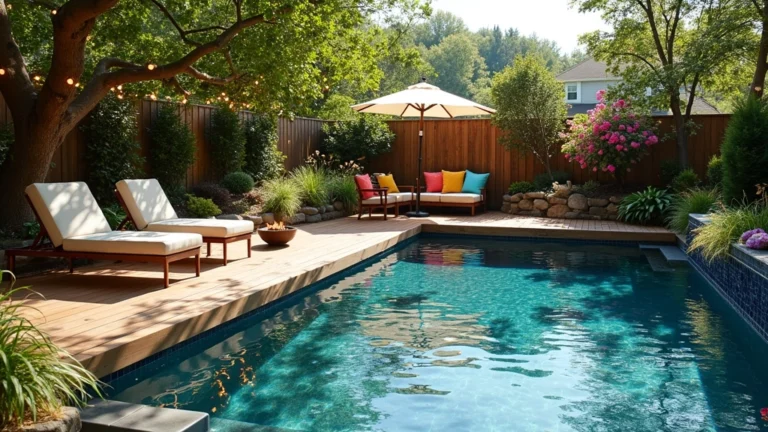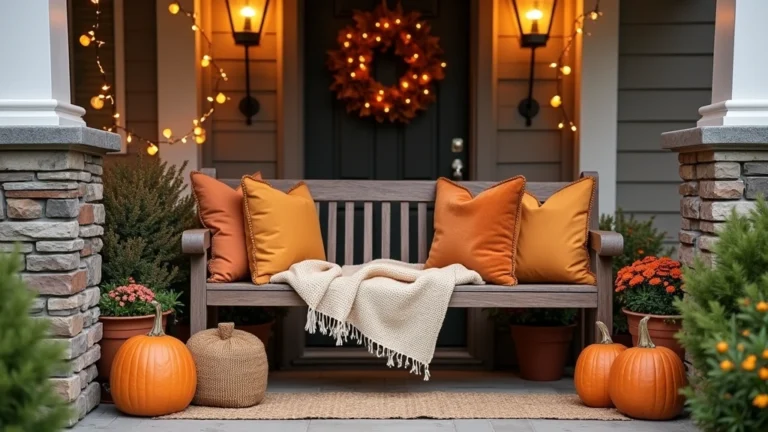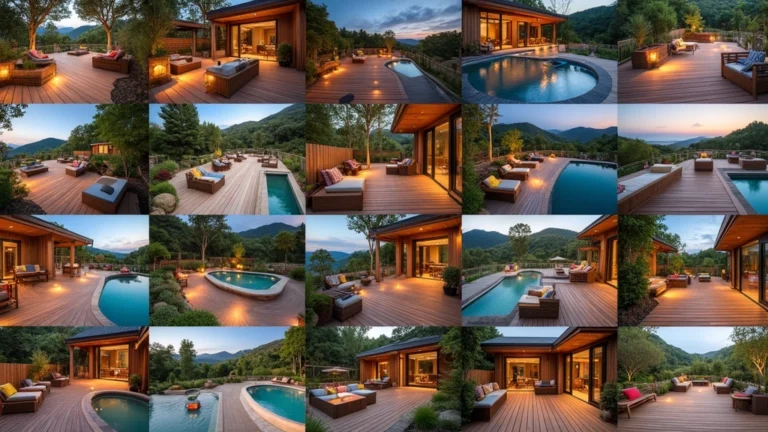19 Eco-Friendly Gazebo Ideas for Sustainable Outdoor Living
A gazebo is more than just an outdoor structure—it’s a personal sanctuary where you sip coffee, host family dinners, or simply watch the seasons unfold. But here’s the truth: not all gazebos are created equal. Some are environmental nightmares made from chemically treated lumber or plastics that won’t break down for centuries. The good news? You can design and build a sustainable gazebo that looks stunning, lasts for years, and doesn’t hurt the planet.
Let’s explore 19 eco-friendly gazebo ideas that blend style with sustainability. Think of it as your secret blueprint for guilt-free outdoor living.
1. Choose Reclaimed Wood for Rustic Charm
Reclaimed wood is like the wise old grandparent of materials—it has stories, character, and a natural patina that new lumber can’t match. By reusing wood from barns, factories, or old flooring, you not only save trees but also cut down on waste clogging up landfills.
According to the Environmental Protection Agency (EPA), construction and demolition debris generated over 600 million tons of waste annually in the U.S. Reusing even a fraction of that reduces the burden.
Personal tip: when I built a pergola in my backyard, I used salvaged oak planks. Every knot and nail mark whispered history, and my guests still compliment its “lived-in elegance.”
2. Go Solar-Powered for Lighting
Forget running ugly extension cords across your lawn. Solar-powered lights are a simple, eco-friendly upgrade that keeps your gazebo glowing long after sunset.
Modern solar panels are more efficient than ever, with conversion rates reaching 22% compared to under 15% a decade ago. Install small solar lanterns, string lights, or even a central solar chandelier. They recharge during the day and set a magical mood at night—all without increasing your electricity bill.
3. Use Bamboo for a Tropical Vibe
Bamboo isn’t just a panda’s favorite snack; it’s a superstar building material. Fast-growing (some species grow up to 35 inches per day), renewable, and incredibly strong, bamboo is often stronger than steel in tensile strength.
A bamboo gazebo feels like stepping into a vacation postcard. It’s lightweight, resistant to pests, and naturally beautiful. Plus, unlike traditional hardwoods that can take 20-50 years to mature, bamboo is harvest-ready in just 3-5 years.
4. Install a Green Roof
Why not turn your gazebo into a tiny eco-paradise by adding a green roof? Planting sedums, moss, or herbs on top not only looks whimsical but also provides insulation and absorbs rainwater.
Green roofs can reduce stormwater runoff by 50–90%, which means less strain on city drains and fewer pollutants washed into rivers. They also attract pollinators like bees and butterflies, turning your gazebo into a mini biodiversity hotspot.
5. Opt for Natural Stone Flooring
Concrete may be cheap, but it has a massive carbon footprint—cement production alone contributes to about 8% of global CO₂ emissions. Instead, go for natural stone like flagstone or slate.
Stone lasts practically forever, requires little maintenance, and blends seamlessly into natural surroundings. You’ll feel grounded (literally) every time you step into your gazebo.
6. Design with Passive Cooling
No one wants to sit in a gazebo that feels like a sauna. Smart design can help you stay cool naturally. Position your gazebo to capture breezes, use open latticework for airflow, and install a slatted roof for filtered sunlight.
Think of it as air conditioning powered by Mother Nature. You’ll reduce reliance on fans or energy-hungry cooling systems while enjoying a naturally comfortable retreat.
7. Use Non-Toxic, Low-VOC Finishes
Here’s a dirty little secret: many paints and sealants release volatile organic compounds (VOCs) that pollute indoor and outdoor air. High VOC levels can trigger headaches, dizziness, and even long-term respiratory problems.
Switch to low-VOC or natural finishes made from plant oils, beeswax, or clay-based paints. They protect your gazebo while keeping the air clean for you and your family.
8. Build Modular and Portable Structures
Not sure if you’ll stay in your home forever? A modular gazebo lets you take it with you when you move. Portable gazebos reduce waste because you’re not tearing down and rebuilding from scratch.
Plus, modular systems often use lighter materials and smart design to minimize environmental impact. It’s like LEGO for adults—functional, fun, and flexible.
9. Collect Rainwater from the Roof
Your gazebo roof isn’t just shade—it’s a rain-catching machine. By attaching gutters and a storage barrel, you can harvest rainwater for watering plants or washing garden tools.
According to the World Wildlife Fund (WWF), nearly 1.1 billion people lack access to clean water globally. While your backyard system won’t solve the crisis, it’s a small way to conserve water and reduce reliance on municipal supplies.
10. Plant Climbing Vines for Natural Shade
Instead of synthetic shades, let nature do the work. Plant climbing vines like wisteria, jasmine, or grapevines around your gazebo. As they grow, they’ll create a living canopy that filters sunlight and cools the air.
The added bonus? Seasonal beauty. You’ll enjoy blossoms in spring, lush greenery in summer, and maybe even grapes for snacking in autumn.
11. Use Recycled Metal for Roofing
Steel and aluminum may sound heavy-duty, but they’re also highly recyclable. In fact, about 75% of all aluminum ever produced is still in use today thanks to recycling.
A recycled metal roof is durable, fire-resistant, and reflects heat—keeping your gazebo cooler in hot weather. Plus, it can last up to 50 years with minimal upkeep.
12. Build with FSC-Certified Lumber
If reclaimed wood isn’t an option, look for FSC-certified lumber. The Forest Stewardship Council (FSC) ensures that wood comes from responsibly managed forests where biodiversity, workers’ rights, and local communities are respected.
Buying FSC-certified lumber means you’re not unknowingly contributing to deforestation, which still destroys 10 million hectares of forest annually, according to the FAO.
13. Add Composting Planters
Blend function with eco flair by attaching composting planters to the sides of your gazebo. You can toss in kitchen scraps, which turn into rich soil over time.
This not only reduces food waste (about 1.3 billion tons globally each year) but also nourishes your garden. Imagine sipping tea while tossing an apple core into your gazebo’s own mini compost bin—practical and oddly satisfying.
14. Use Hempcrete for Walls
If you want a more enclosed gazebo, consider hempcrete. Made from hemp hurds, lime, and water, it’s lightweight, breathable, and carbon-negative. That means it absorbs more CO₂ than it emits during production.
Hemp grows fast—maturing in 3–4 months—and requires little water or pesticides. Hempcrete walls provide excellent insulation, keeping your gazebo cozy without mechanical heating or cooling.
15. Incorporate Upcycled Décor
Why buy new when you can upcycle? Old wine barrels can become side tables, pallets can transform into benches, and antique lanterns can add character.
Upcycling reduces waste, saves money, and gives your gazebo a unique personality. Trust me: guests will be far more impressed with your “found treasures” than with cookie-cutter store-bought décor.
16. Integrate Wildlife-Friendly Features
Your gazebo doesn’t just serve you—it can serve the local ecosystem too. Add birdhouses, bee hotels, or butterfly feeders nearby. These small touches support declining pollinator populations.
For context, 40% of insect pollinators are at risk of extinction, according to the UN. By making your gazebo wildlife-friendly, you’re turning leisure space into a micro-habitat.
17. Use Local Materials
Transporting materials across continents racks up a hefty carbon footprint. Whenever possible, choose locally sourced stone, wood, or clay tiles. Not only will you support local economies, but you’ll also cut down on emissions.
As a bonus, local materials often blend better with your natural landscape, creating a gazebo that feels like it truly belongs.
18. Install Energy-Efficient Fans
Sometimes a gentle breeze just isn’t enough. Instead of heavy-duty cooling systems, add energy-efficient ceiling or wall-mounted fans powered by solar panels.
Modern DC motor fans use up to 70% less energy than traditional AC motor fans. Pairing them with renewable energy makes your gazebo both comfortable and eco-conscious.
19. Experiment with Earthbag Foundations
Instead of pouring a concrete slab, try earthbag foundations. These involve stacking bags filled with local soil to form sturdy, low-impact bases. They’re strong, inexpensive, and reduce the need for cement.
Earthbag construction has been used for centuries and is making a comeback in sustainable architecture. It’s like building sandcastles for adults—but with lasting results.
Conclusion on 19 Eco-Friendly Gazebo Ideas for Sustainable Outdoor Living
Designing an eco-friendly gazebo isn’t just about creating shade; it’s about creating a statement. Each of these 19 sustainable ideas—from reclaimed wood and bamboo to green roofs and rainwater harvesting—represents a small but powerful step toward living more harmoniously with nature.
Think of your gazebo as a conversation between you and the planet. Every material, every design choice, every solar panel or climbing vine is your way of saying: “I care, and I’m doing my part.”
So whether you’re sipping lemonade under a vine-covered roof, listening to bees buzz around wildflowers nearby, or watching solar lanterns twinkle at dusk, you’ll know your outdoor retreat isn’t just beautiful—it’s responsible. And that’s the kind of luxury no store-bought gazebo can match.





